DNVGL-ST-0142 Offshore Platform Fatigue Testing
The DNVGL-ST-0142 standard is a critical document for the design, construction, and operation of offshore platforms. This standard defines the testing procedures to ensure that these structures can withstand the dynamic loads they are subjected to during their operational life. The fatigue testing outlined in this document plays a pivotal role in verifying the structural integrity of offshore platforms.
Offshore platforms operate in harsh environments where constant exposure to waves, wind, and other environmental factors contributes significantly to structural stress. Over time, these stresses can lead to fatigue failures, which are particularly dangerous in marine structures. DNVGL-ST-0142 provides a standardized approach for assessing the fatigue resistance of offshore platforms, ensuring that they meet stringent safety requirements set by international standards.
The testing procedure involves subjecting models or prototypes of the platform to cyclic loading conditions that mimic real-world scenarios. This process simulates the dynamic forces experienced during typical operations and extreme weather events. The aim is to identify any potential weaknesses in the design before full-scale construction, thus preventing costly failures post-commissioning.
The methodology described in DNVGL-ST-0142 includes detailed instructions on specimen preparation, instrumentation setup, data acquisition, and analysis techniques. It emphasizes the importance of accurate measurement and recording of all relevant parameters to ensure reliable test results. Compliance with this standard is not only a regulatory requirement but also enhances the reputation and marketability of offshore platforms.
One of the key aspects of DNVGL-ST-0142 is its emphasis on continuous improvement through feedback loops derived from testing outcomes. This iterative process ensures that best practices evolve over time, leading to safer and more efficient designs. By adhering to this standard, stakeholders can rest assured that their projects comply with the highest industry standards.
The fatigue testing protocol described in DNVGL-ST-0142 is comprehensive yet flexible enough to accommodate various types of offshore platforms. It caters to different stages of development, from concept design through final commissioning. The standard provides clear guidelines on how to interpret test results and make informed decisions regarding modifications or enhancements.
Understanding the nuances of this testing protocol requires familiarity with both theoretical principles and practical applications. Our team has extensive experience in conducting fatigue tests according to DNVGL-ST-0142, leveraging advanced equipment and expertise to deliver accurate and reliable results. We work closely with clients throughout the entire process to ensure that each step aligns perfectly with their project goals.
Benefits
- Enhanced safety by identifying potential weaknesses early in the design phase
- Compliance with international standards ensuring regulatory approval and market acceptance
- Promotion of continuous improvement through iterative testing processes
- Reduction of risks associated with fatigue failure leading to significant cost savings
- Elevated reputation among peers, clients, and stakeholders emphasizing commitment to quality and safety
International Acceptance and Recognition
The DNVGL-ST-0142 standard enjoys widespread recognition within the maritime sector, particularly for offshore platforms. Its acceptance spans multiple countries due to its alignment with international standards such as ISO 9693 and IEC 61850. Many regulatory bodies worldwide have adopted these guidelines, further solidifying their importance in global marine engineering.
Adhering to this standard not only meets legal requirements but also demonstrates a commitment to excellence. It is valued by insurers who consider compliance as an indicator of reduced risk. Additionally, it provides confidence to investors looking for robust and reliable infrastructure projects.
Use Cases and Application Examples
| Case Study | Description |
|---|---|
| Platform A | Testing of a semi-submersible platform to ensure it can withstand severe weather conditions. |
| Subsea Cable Installation | Evaluation of subsea cable strength under various loading scenarios simulating deployment in deep waters. |
| Case Study | Description |
|---|---|
| Platform B | Detailed fatigue testing on a floating production storage and offloading (FPSO) vessel to assess its resilience against continuous motion. |
| Offshore Wind Turbine Support Structures | Analysis of wind turbine support structures to ensure they can endure prolonged exposure to high winds without failure. |





